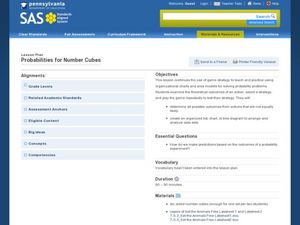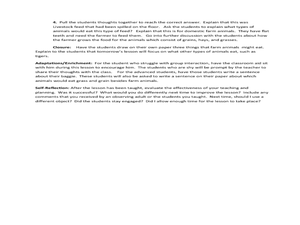Curated OER
Hatching Chickens
Students observe chicks hatching from eggs. In this science lesson plan, students view a video to develop an understanding of the proper care and needs of eggs and live animals. This is a great precursor activity for hatching eggs in class.
Curated OER
Probabilities for Number Cubes
Middle schoolers explore the concept of probability. In this probability lesson, students roll a six-sided number cube and record the frequency of each outcome. Middle schoolers graph their data using a frequency chart and keep tally...
Curated OER
Penguin Worksheet
In this animal science worksheet, learners answer fifteen questions about penguins. The questions included true or false and fill in the blanks. Students will need prior knowledge about penguins to complete this worksheet. The questions...
Curated OER
Horseshoe Crab Fun
Marine biology masters will meet the horseshoe crab and red knot shore birds that feast upon the crab eggs. Begin with a discussion and then have learners write postcards from each animal detailing their migration trips. A few math...
Sea World
Shark!
Is that a shark? Here's a 10-lesson unit that will have learners expanding their definition of what a shark actually is as they examine different features, habitats, and diets. They explore endangered species, using information cards...
Curated OER
Alphabetizing Animals
Students explore alphabetization. In this alphabetical order lesson, students complete a worksheet which lists an animal name for each of the first 7 letters of the alphabet.
Curated OER
Awesome Animals
Students collect data from classmates about their favorite animal. They use the ClarisWorks graphing program to enter data, graph results, and interpret data.
Curated OER
Animal Life Histories Derived From Morphology
Learners learn the mechanisms of natural selection by deducing information from the physical appearance of the animal.
Curated OER
Artic/Antarctic Animals
Fourth graders create an organized report which includes specific information about their assigned animal. They use the Alpha Smarts program and Microsoft Word to create their reports.
Curated OER
Alphabetizing Animals
Students listen to an explanation of how to put words in alphabetical order with examples provided. Students complete the worksheet to alphabetize animal names independently.
Curated OER
Must Love Animals!
Students research an animal and present their findings in an AppleWorks slideshow using computers, internet access, and Inspiration educational software. This lesson is intended for a middle-level Language Arts or Science classroom.
Curated OER
Vocabulary; Idioms/Phrasal Verbs Using Names of Animals,-Part 1
In this foreign language worksheet, students read ten sentences with missing words. They select the best word to fill in the blank from a list of three that are given. Each sentence contains an idiomatic phrase.
Curated OER
Why Do We Need Petroleum?
Students learn the many ways petroleum is used in our industrial society, and the advantages and disadvantages of its use. They explore what it would be like to live in a world without petroleum.
Curated OER
Creature Features
Learners examine why certain animals live in only specific places throughout the world. Using animals, they classify them based on their characteristics and identify their basic needs. They also observe and compare the life cycles of...
Curated OER
What's in it and Who Eats it?
First graders explore farming by illustrating images. In this livestock lesson, 1st graders discuss what types of plants are used to feed livestock animals and how pets and humans eat the livestock animals. Students draw images of what...
Curated OER
Habitat
Students are able to define habitat. They are able to identify the four things that living things need to survive. Students are able to describe how living things are adapted to their habitats.
Curated OER
Mammals Have Fur
First graders study animals. In this animal classification instructional activity, 1st graders explore the characteristics (primarily fur) that distinguish animals as mammals. They work in groups at various stations that practice this...
Curated OER
Mammals Have hair or Fur
First graders complete computer activities, make a mask, separate pictures, and more having to do with mammals. In this mammals lesson plan, 1st graders classify animals as being mammals or non mammals based on their hair or fur.
Curated OER
Thank You For the Food We Eat
Students explore where our food comes from. In this science activity, students discuss how much of our food comes from animals. Students construct a mobile.
Curated OER
The Salamander Room
Students examine how each animal's habitat provides what that animal needs for survival. They discuss what an animal needs to survive-food, shelter, water, and space.
Curated OER
Habits: An Introduction
Second graders identify different types of habitats animals live in to have a better understanding of the world around them. They choose a habitat, draw a picture of an animal that lives there and list the unique attributes the habitat...
Curated OER
Environmental Conditions: Friend or Foe
Students research and answer questions on how organisms are classified and how their needs are met through their environment. They work in small groups and create a poster, chart, rap, PowerPoint, or brochure demonstrating how organisms...
Curated OER
Pio, Pio, Que Frio
Pupils investigate the characteristics of living things. They determine that different organisms have different needs and describe and compare them. They draw and verbally respond about their favorite animal.
Curated OER
Different Ways to Divide
In this division learning exercise, students use data about pet store animals found in a given chart to solve 6 division problems, telling which method of division was used.

























